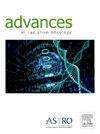Prospective Study of Patients Treated with Palliative Radiation Therapy While on Immunotherapy
IF 2.7
Q3 ONCOLOGY
引用次数: 0
Abstract
Purpose
To prospectively document the outcomes of patients treated with palliative radiation therapy (RT) who are receiving immunotherapy.
Methods and Materials
Patients with advanced cancer receiving or planning to commence immunotherapy within 28 days who were referred for palliative RT at our center between January 2017 and September 2019 were screened for participation in this prospective observational study. Demographic and treatment data, along with patient-reported outcomes (PROs) using the Edmonton Symptom Assessment Scale for cancer, were collected at baseline, after 1 month, and then every 3 months for up to 1 year or until death. RT dose and fractionation were at the discretion of the treating radiation oncologist. Immunotherapy was given as per the standard of care protocol. The primary outcome was 3-month toxicity. Secondary outcomes included response evaluation criteria in solid tumors version 1.1 (RECIST v1.1) response on computed tomography scan performed 1, 3, and 6 months post-RT. The feasibility of enhancing PRO compliance using caregiver-aided PROs and virtual PRO collection was explored.
Results
Thirty-nine patients who received 50 courses of palliative RT (most often for pain) and who also received immunotherapy within 28 days of RT were evaluated for toxicity at 3 months post-RT. The most common primary cancer was non-small cell lung cancer (38%), followed by melanoma (36%). The most common RT dose was 20 Gy in 5 fractions (42%). 87% of patients (34/39) received a programmed cell death protein 1 inhibitor alone. An interval of <14 days between RT and immunotherapy. No grade 3 or higher toxicity was attributable to combined treatment. The median survival for the cohort was 11 months. At 3 months, 26 patients had imaging available for RECIST v1.1; 14 of 26 (54%) had an in-field response, and 3 of 26 (12%) had stable disease (with mixed out-of-field response). Compliance with PROs was 79% (31/39) at 1 month and 69% (27/39) at 3 months. Ten of the 31 patients (32%) and 11 of 31 patients (41%) used caregiver-aided PRO collection.
Conclusions
Palliative RT appears safe in patients receiving immunotherapy with no apparent increase in toxicity because of the combination. Responses out of irradiated volumes were no better than expected than with immunotherapy alone. Caregiver-aided PROs improved compliance with PRO data collection and were feasible.
姑息性放射治疗与免疫治疗的前瞻性研究
目的前瞻性地记录姑息性放射治疗(RT)患者同时接受免疫治疗的结果。方法和材料筛选2017年1月至2019年9月期间在我们中心转介姑息性放疗的接受或计划在28天内开始免疫治疗的晚期癌症患者参与本前瞻性观察性研究。人口统计和治疗数据,以及使用埃德蒙顿癌症症状评估量表的患者报告的结果(PROs),在基线、1个月后收集,然后每3个月收集一次,持续1年或直到死亡。放疗剂量和分割由治疗放射肿瘤学家决定。按照标准治疗方案给予免疫治疗。主要终点为3个月毒性。次要结局包括实体瘤1.1版(RECIST v1.1)的应答评价标准,在放疗后1、3和6个月进行计算机断层扫描时的应答。探讨使用护理人员辅助PRO和虚拟PRO收集提高PRO依从性的可行性。结果39例患者接受了50个疗程的姑息性放射治疗(主要针对疼痛),并在放射治疗后28天内接受了免疫治疗,在放射治疗后3个月进行了毒性评估。最常见的原发癌症是非小细胞肺癌(38%),其次是黑色素瘤(36%)。最常见的放射治疗剂量为5次20 Gy(42%)。87%的患者(34/39)单独接受了程序性细胞死亡蛋白1抑制剂。放疗与免疫治疗之间的间隔为14天。没有3级或更高的毒性可归因于联合治疗。该队列的中位生存期为11个月。3个月时,26例患者可进行RECIST v1.1成像;26例中有14例(54%)有田间反应,26例中有3例(12%)病情稳定(有混合的田间反应)。1个月时,PROs的依从性为79%(31/39),3个月时为69%(27/39)。31例患者中有10例(32%)和11例(41%)使用护理人员辅助PRO收集。结论姑息性放疗在接受免疫治疗的患者中是安全的,没有因联合治疗而明显增加毒性。放射体积外的反应并不比单独免疫治疗好。护理人员辅助的PRO提高了PRO数据收集的依从性,并且是可行的。
本文章由计算机程序翻译,如有差异,请以英文原文为准。
求助全文
约1分钟内获得全文
求助全文
来源期刊

Advances in Radiation Oncology
Medicine-Radiology, Nuclear Medicine and Imaging
CiteScore
4.60
自引率
4.30%
发文量
208
审稿时长
98 days
期刊介绍:
The purpose of Advances is to provide information for clinicians who use radiation therapy by publishing: Clinical trial reports and reanalyses. Basic science original reports. Manuscripts examining health services research, comparative and cost effectiveness research, and systematic reviews. Case reports documenting unusual problems and solutions. High quality multi and single institutional series, as well as other novel retrospective hypothesis generating series. Timely critical reviews on important topics in radiation oncology, such as side effects. Articles reporting the natural history of disease and patterns of failure, particularly as they relate to treatment volume delineation. Articles on safety and quality in radiation therapy. Essays on clinical experience. Articles on practice transformation in radiation oncology, in particular: Aspects of health policy that may impact the future practice of radiation oncology. How information technology, such as data analytics and systems innovations, will change radiation oncology practice. Articles on imaging as they relate to radiation therapy treatment.
 求助内容:
求助内容: 应助结果提醒方式:
应助结果提醒方式:


